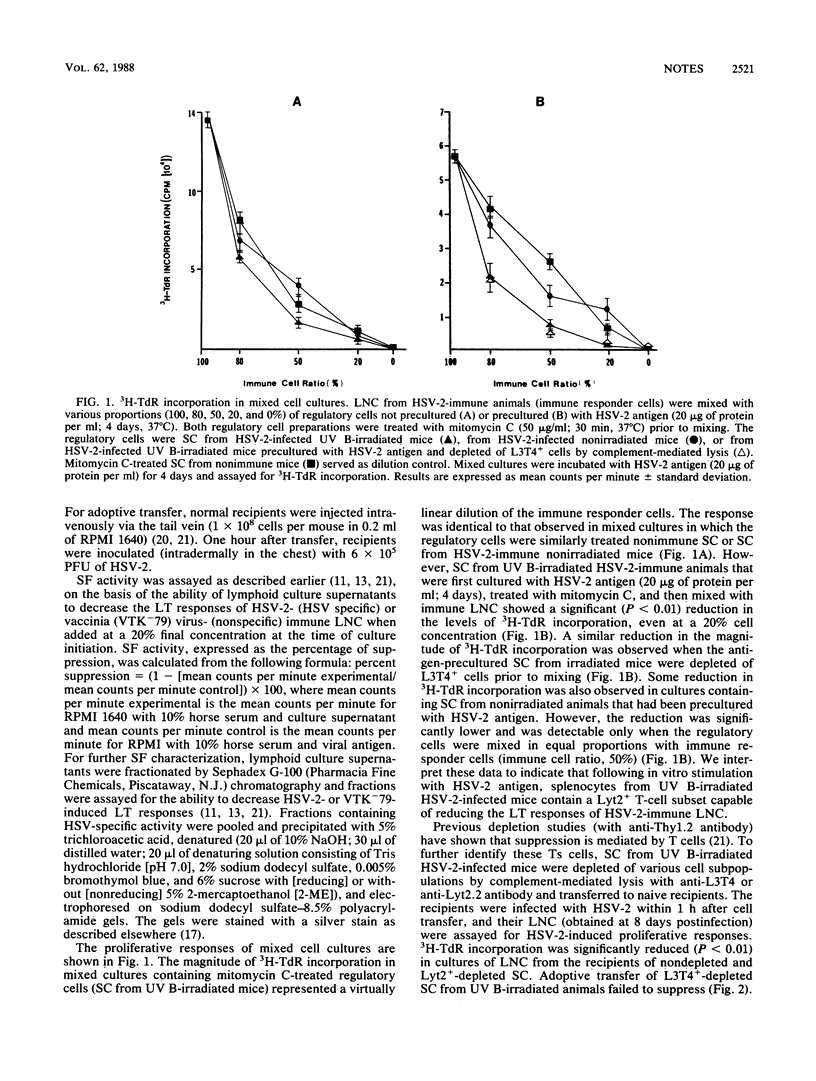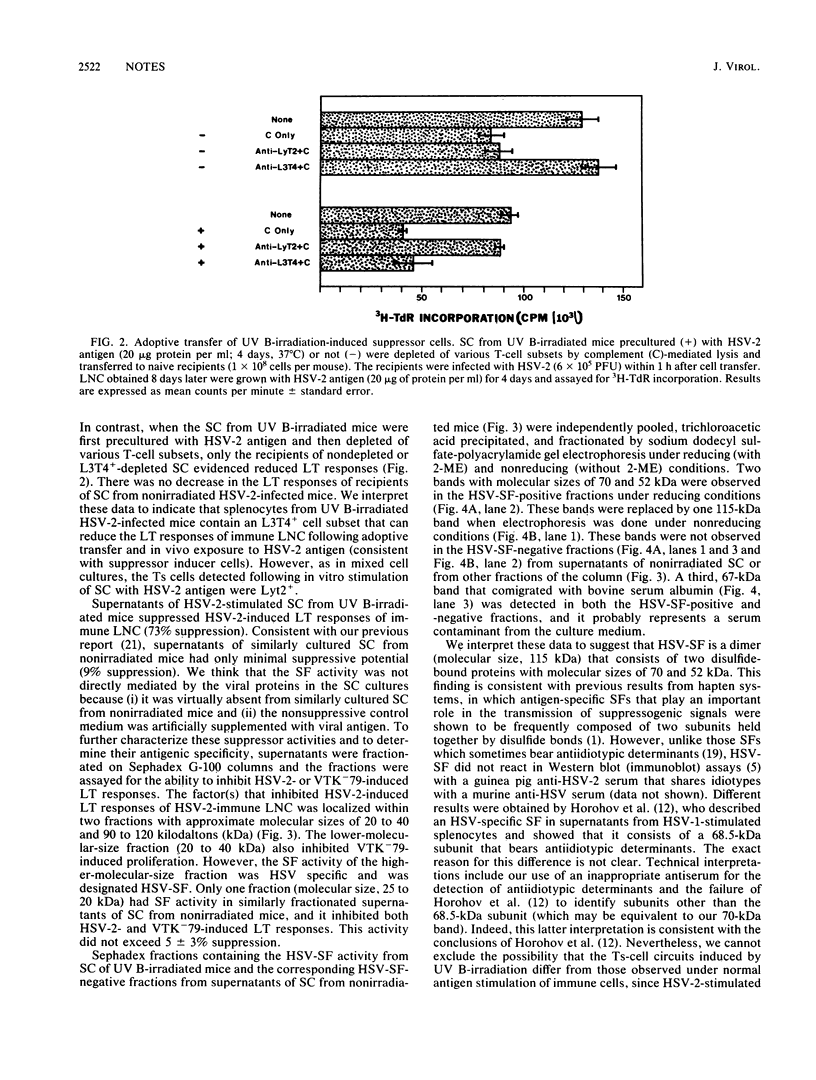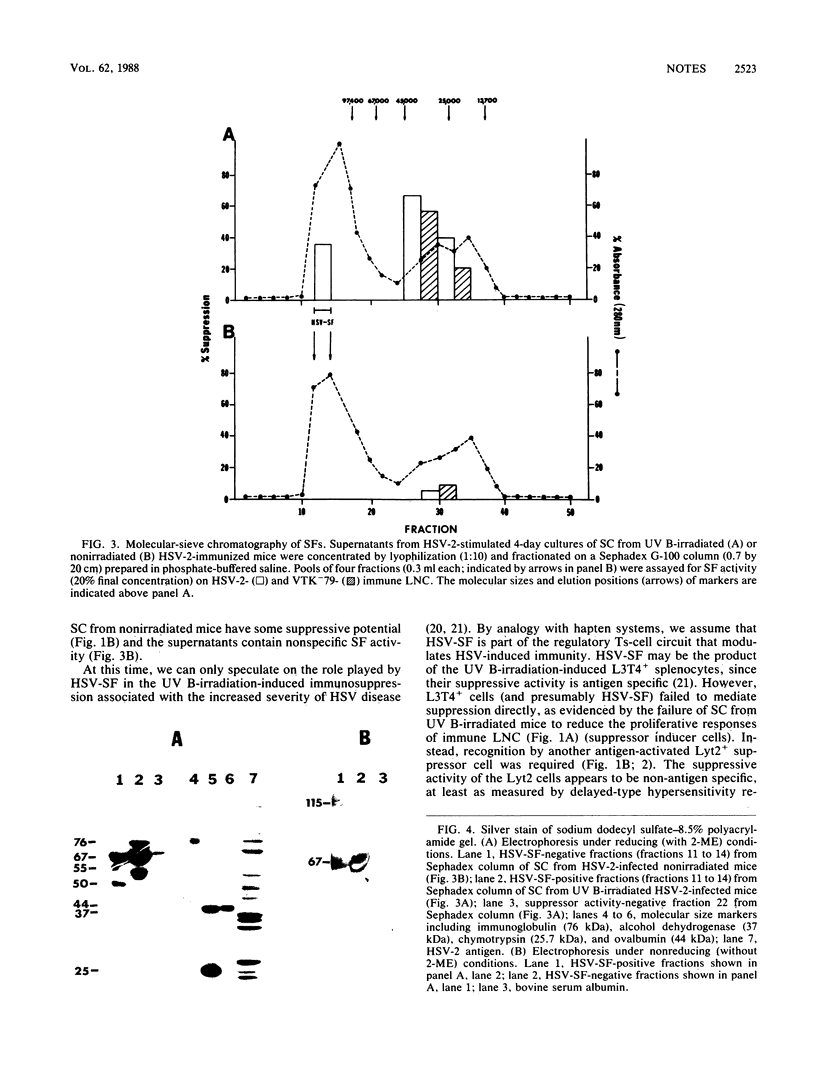Abstract
UV B-irradiation (280 to 320 nm) of mice at the site of cutaneous infection with herpes simplex virus type 2 (HSV-2) induced suppressor T-cell circuits that decreased HSV-2-induced proliferative responses of HSV-2-immune lymph node cells. Adoptive transfer experiments indicated that splenocytes from UV B-irradiated HSV-2-infected animals contain L3T4+ cells that suppress proliferative responses in vivo, consistent with suppressor inducer cells. However, following in vitro culture of the splenocytes with HSV-2 antigen, the proliferation of immune lymph node cells was inhibited by Lyt2+ suppressor T cells, consistent with antigen-induced suppressor effector cells. Antigen-specific and nonspecific suppressor factors were fractionated from supernatants of HSV-2-stimulated spleen cells by molecular-sieve chromatography. Sodium dodecyl sulfate-polyacrylamide gel electrophoresis of the Sephadex fraction that contained the antigen-specific suppressor factor, in the presence or absence of 2-mercaptoethanol, defined a 115-kilodalton protein consisting of two disulfide-bound components with molecular sizes of 70 and 52 kilodaltons. The implications of these results with respect to the regulation of HSV-induced cell-mediated immunity following UV B-irradiation are discussed.
Full text
PDF




Images in this article
Selected References
These references are in PubMed. This may not be the complete list of references from this article.
- Aoki I., Minami M., Dorf M. E. A mechanism responsible for the induction of H-2 restricted second order suppressor T cells. J Exp Med. 1983 Jun 1;157(6):1726–1735. doi: 10.1084/jem.157.6.1726. [DOI] [PMC free article] [PubMed] [Google Scholar]
- Asherson G. L., Watkins M. C., Zembala M. A., Colizzi V. C. Two-chain structure of T-suppressor factor: antigen-specific T-suppressor factor occurs as a single molecule and as separate antigen-binding and I-J+ parts, both of which are required for biological activity. Cell Immunol. 1984 Jul;86(2):448–459. doi: 10.1016/0008-8749(84)90400-3. [DOI] [PubMed] [Google Scholar]
- Blyth W. A., Hill T. J., Field H. J., Harbour D. A. Reactivation of herpes simplex virus infection by ultraviolet light and possible involvement of prostaglandins. J Gen Virol. 1976 Dec;33(3):547–550. doi: 10.1099/0022-1317-33-3-547. [DOI] [PubMed] [Google Scholar]
- Chong K. T., Mims C. A. Antigen-specific suppression of delayed type hypersensitivity to murine cytomegalovirus in MCMV-infected mice. J Gen Virol. 1983 Nov;64(Pt 11):2433–2439. doi: 10.1099/0022-1317-64-11-2433. [DOI] [PubMed] [Google Scholar]
- Costa S., Smith C. C., Taylor S., Aurelian L., Orlandi C. Intracellular localization and serological identification of a HSV-2 protein in cervical cancer. Eur J Gynaecol Oncol. 1986;7(1):1–12. [PubMed] [Google Scholar]
- Donnenberg A. D., Chaikof E., Aurelian L. Immunity to herpes simplex virus type 2: cell-mediated immunity in latently infected guinea pigs. Infect Immun. 1980 Oct;30(1):99–109. doi: 10.1128/iai.30.1.99-109.1980. [DOI] [PMC free article] [PubMed] [Google Scholar]
- Dorf M. E., Benacerraf B. Suppressor cells and immunoregulation. Annu Rev Immunol. 1984;2:127–157. doi: 10.1146/annurev.iy.02.040184.001015. [DOI] [PubMed] [Google Scholar]
- Granstein R. D., Morison W. L., Kripke M. L. The role of suppressor cells in the induction of murine photoallergic contact dermatitis and in its suppression by prior UVB irradiation. J Immunol. 1983 May;130(5):2099–2103. [PubMed] [Google Scholar]
- Greene M. I., Weiner H. L. Delayed hypersensitivity in mice infected with reovirus. II. Induction of tolerance and suppressor T cells to viral specific gene products. J Immunol. 1980 Jul;125(1):283–287. [PubMed] [Google Scholar]
- Harbour D. A., Hill T. J., Blyth W. A. Recurrent herpes simplex in the mouse: inflammation in the skin and activation of virus in the ganglia following peripheral stimulation. J Gen Virol. 1983 Jul;64(Pt 7):1491–1498. doi: 10.1099/0022-1317-64-7-1491. [DOI] [PubMed] [Google Scholar]
- Hayashi Y., Aurelian L. Immunity to herpes simplex virus type 2: viral antigen-presenting capacity of epidermal cells and its impairment by ultraviolet irradiation. J Immunol. 1986 Feb 1;136(3):1087–1092. [PubMed] [Google Scholar]
- Horohov D. W., Wyckoff J. H., 3rd, Moore R. N., Rouse B. T. Regulation of herpes simplex virus-specific cell-mediated immunity by a specific suppressor factor. J Virol. 1986 May;58(2):331–338. doi: 10.1128/jvi.58.2.331-338.1986. [DOI] [PMC free article] [PubMed] [Google Scholar]
- Iwasaka T., Sheridan J. F., Aurelian L. Immunity to herpes simplex virus type 2: recurrent lesions are associated with the induction of suppressor cells and soluble suppressor factors. Infect Immun. 1983 Dec;42(3):955–964. doi: 10.1128/iai.42.3.955-964.1983. [DOI] [PMC free article] [PubMed] [Google Scholar]
- Malkovský M., Asherson G. L., Chandler P., Colizzi V., Watkins M. C., Zembala M. Nonspecific inhibitor of DNA synthesis elaborated by T acceptor cells. I. Specific hapten- and I-J-driven liberation of an inhibitor of cell proliferation by Lyt-1-2+ cyclophosphamide-sensitive T acceptor cells armed with a product of Lyt-1+2+-specific suppressor cells. J Immunol. 1983 Feb;130(2):785–790. [PubMed] [Google Scholar]
- Petit J. C., Richard G., Albert B., Daguet G. L. Depression by Pseudomonas aeruginosa of two T-cell-mediated responses, anti-Listeria immunity and delayed-type hypersensitivity to sheep erythrocytes. Infect Immun. 1982 Mar;35(3):900–908. doi: 10.1128/iai.35.3.900-908.1982. [DOI] [PMC free article] [PubMed] [Google Scholar]
- Sheridan J. F., Beck M., Aurelian L., Radowsky M. Immunity to herpes simplex virus: virus reactivation modulates lymphokine activity. J Infect Dis. 1985 Sep;152(3):449–456. doi: 10.1093/infdis/152.3.449. [DOI] [PubMed] [Google Scholar]
- Sheridan J. F., Beck M., Smith C. C., Aurelian L. Reactivation of herpes simplex virus is associated with production of a low molecular weight factor that inhibits lymphokine activity in vitro. J Immunol. 1987 Feb 15;138(4):1234–1239. [PubMed] [Google Scholar]
- Sheridan J. F., Donnenberg A. D., Aurelian L., Elpern D. J. Immunity to herpes simplex virus type 2. IV. Impaired lymphokine production during recrudescence correlates with an imbalance in T lymphocyte subsets. J Immunol. 1982 Jul;129(1):326–331. [PubMed] [Google Scholar]
- Sumida T., Takei I., Taniguchi M. Activation of acceptor-suppressor hybridoma with antigen-specific suppressor T cell factor of two-chain type: requirement of the antigen- and the I-J-restricting specificity. J Immunol. 1984 Sep;133(3):1131–1136. [PubMed] [Google Scholar]
- Yasumoto S., Hayashi Y., Aurelian L. Immunity to herpes simplex virus type 2. Suppression of virus-induced immune responses in ultraviolet B-irradiated mice. J Immunol. 1987 Oct 15;139(8):2788–2793. [PubMed] [Google Scholar]
- Yasumoto S., Okabe N., Mori R. Role of epidermal Langerhans cells in resistance to herpes simplex virus infection. Arch Virol. 1986;90(3-4):261–271. doi: 10.1007/BF01317375. [DOI] [PubMed] [Google Scholar]



